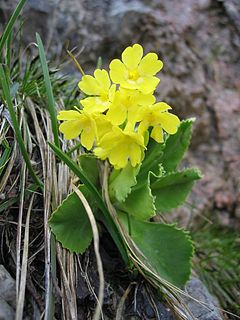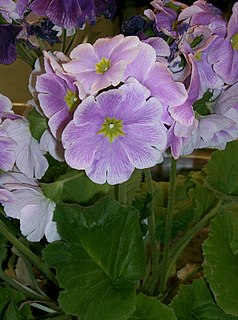
Primula is a genus of mainly herbaceous flowering plants in the family Primulaceae. They include the familiar wildflower of banks and verges, the primrose. Other common species are P. auricula (auricula), P. veris (cowslip), and P. elatior (oxlip). These species and many others are valued for their ornamental flowers. They have been extensively cultivated and hybridised. Primula are native to the temperate Northern Hemisphere, south into tropical mountains in Ethiopia, Indonesia, and New Guinea, and in temperate southern South America. Almost half of the known species are from the Himalayas.

Alstroemeria, commonly called the Peruvian lily or lily of the Incas, is a genus of flowering plants in the family Alstroemeriaceae. They are all native to South America although some have become naturalized in the United States, Mexico, Australia, New Zealand, Madeira and the Canary Islands. Almost all of the species are restricted to one of two distinct centers of diversity, one in central Chile, the other in eastern Brazil. Species of Alstroemeria from Chile are winter-growing plants while those of Brazil are summer growing. All are long-lived perennials except A. graminea, a diminutive annual from the Atacama Desert of Chile.

Primula hendersonii is a species of flowering plant in the family Primulaceae, native to western North America, from California north to southern British Columbia and Idaho. Common names include broad-leaved shooting star, Henderson's shooting star, mosquito bills, and sailor caps.

Primula bulleyana is a species of flowering plant in the family Primulaceae, native to hillsides in China.

Hyacinthus orientalis, the common hyacinth, garden hyacinth or Dutch hyacinth, is a species of flowering plant in the family Asparagaceae, subfamily Scilloidiae, native to southwestern Asia, southern and central Turkey, northwestern Syria, Lebanon and northern Israel. It was introduced to Europe in the 16th century. It is widely cultivated everywhere in the temperate world for its strongly fragrant flowers which appear exceptionally early in the season, and frequently forced to flower at Christmas time.

Primula vulgaris, the common primrose, is a species of flowering plant in the family Primulaceae, native to western and southern Europe, northwest Africa, and parts of southwest Asia. The common name is primrose, or occasionally common primrose or English primrose to distinguish it from other Primula species also called primroses. None of these are closely related to the evening primroses.

Primula auricula, often known as auricula, mountain cowslip or bear's ear, is a species of flowering plant in the family Primulaceae, that grows on basic rocks in the mountain ranges of central Europe, including the western Alps, Jura mountains, the Vosges, the Black Forest and the Tatra Mountains.

Primula florindae, the Tibetan cowslip or giant cowslip, is a species of flowering plant in the family Primulaceae, native to southeastern Tibet, where it grows in huge numbers close to rivers such as the Tsangpo. It is a substantial herbaceous perennial growing to 120 cm (47 in) tall by 90 cm (35 in) wide. In summer the flower stalks rise from basal rosettes of 5–20 cm (2–8 in) long leaves. They bear clusters of 20–40 yellow, pendent, bell-like, delicately scented flowers with a mealy white bloom.

Primula elatior, the oxlip, is a species of flowering plant in the family Primulaceae, native to nutrient-poor and calcium-rich damp woods and meadows throughout Europe, with northern borders in Denmark and southern parts of Sweden, eastwards to the Altai Mountains and on the Kola Peninsula in Russia, and westwards in the British Isles.

Myosotis sylvatica, the wood forget-me-not or woodland forget-me-not, is a species of flowering plant in the family Boraginaceae, native to Europe. This spring-flowering plant and its cultivars, typically with blue flowers, are the familiar forget-me-nots of gardens.

Primula meadia, the shooting star or eastern shooting star, is a species of flowering plant in the primrose family Primulaceae. It is native to the eastern United States and Canada, spanning north from Manitoba and New York, south to Texas and Florida.

Primula denticulata, the drumstick primula, is a species of flowering plant in the family Primulaceae, native to moist alpine regions of China, Afghanistan, Bhutan, India, Kashmir, N Myanmar, Nepal, and Pakistan. It is an herbaceous perennial growing to 45 cm (18 in) tall and wide, with rosettes of oval leaves and sturdy stems bearing spherical umbels of purple flowers in late spring and early summer. Flowers can also be lavender, pink, or white in colour.

Primula rosea, the rosy primrose, is a flowering plant species in the genus Primula, native to the Himalayas. Growing to 50 cm (20 in) tall, it is a hardy herbaceous perennial with red-tinged leaves and clumps of rich pink flowers in spring.

Primula sikkimensis is a species of flowering plant in the family Primulaceae, native to the Himalayan region at altitudes of 3,200–4,400 m (10,499–14,436 ft), from western Nepal to south west China. It is an herbaceous perennial growing to 90 cm (35 in) tall by 60 cm (24 in) broad, with umbels of fragrant yellow flowers, appearing in summer on slender stems which arise from basal rosettes of leaves. The flowers may be covered by a mealy-white layer (farina).

Primula japonica, the Japanese primrose, Japanese cowslip, Queen of primroses, or valley red, is a species of flowering plant in the family Primulaceae, native to Japan. The common name Japanese primrose also applies to the related species Primula sieboldii.

Primula marginata, the silver-edged primrose, is a species of flowering plant in the family Primulaceae, native to the south western Alps of France and Italy.

Primula obconica is a species of flowering plant in the family Primulaceae, native to China. It is a short-lived evergreen perennial growing to 40 cm (16 in) tall by 25 cm (10 in) broad, with rosettes of coarse, heart-shaped leaves, and thick stalks bearing umbels of lavender flowers in late winter and early spring.

Primula pulverulenta, the mealy primrose or mealy cowslip, is a species of flowering plant in the family Primulaceae, native to damp habitats in China. It is a herbaceous perennial growing to 100 cm (39 in) tall by 60 cm (24 in) broad, with strong stems of deep pink flowers arising from basal rosettes of leaves in early summer. The flowers are grouped at intervals along the stem in a tiered formation, hence the common name "candelabra primula" which is often applied to this and other species with a similar arrangement.

Primula vialii, Vial's primrose, is a species of flowering plant in the family Primulaceae, originating from wet meadows, or near water in high valleys of SW Sichuan and northern Yunnan in southern China. Growing to 40 cm (16 in), it is a herbaceous perennial with erect stalks of flowers growing from basal rosettes of leaves. The flowers initially appear as narrow green spikes turning red, then opening pink from the base upwards, thus giving a striking bicoloured appearance.

Primula frondosa, the leafy primrose, is a species of flowering plant in the family Primulaceae, native to the Balkans. It inhabits shady spots in a small region of the central Balkan Mountains range in Bulgaria, where it is found at altitudes from 800 to 2,200 m. Its populations are situated within the boundaries of the Central Balkan National Park and the nature reserves Sokolna, Dzhendema and Stara Reka.



















